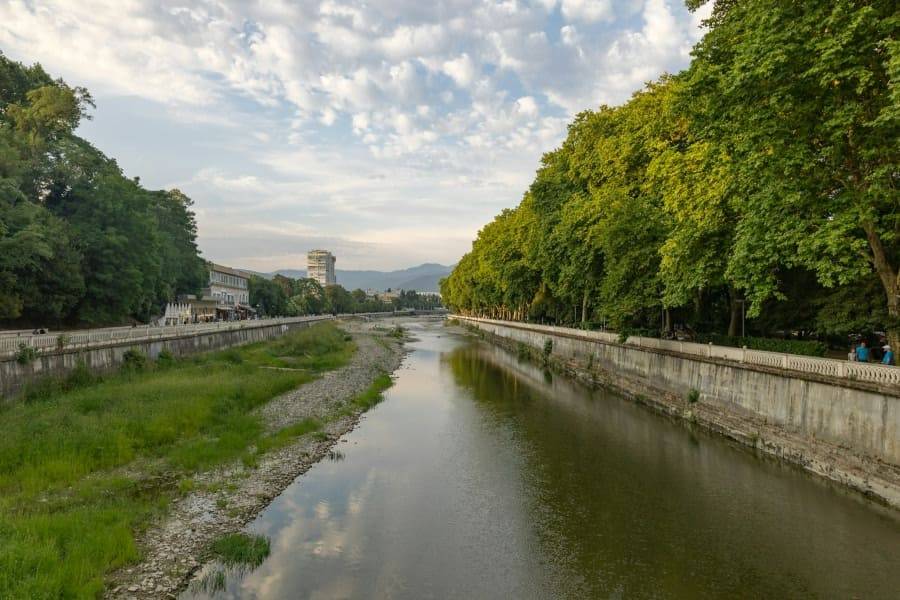You will hear part of a presentation by an urban planning student about the role of rivers in cities around the world.
First, you have some time to look at questions thirty-one to forty.
Now listen carefully and answer questions thirty-one to forty.
It's quite hard to think of a city that doesn't have a big river running through it.
If you think about the major cities in the world, Shanghai, New York, Mumbai, London, they're nearly all built on rivers.
When these cities were established hundreds or even thousands of years ago, the rivers were a big part of people's lives.
In sixteenth-century London, the quickest way to get from one part of the city to another was by river.
But people also used the river for fishing, as the water then was relatively clean, and they would also go on boat trips up and down the river just for pleasure, as a relaxing escape from the noise and bustle of the city streets.
But as industries developed and populations increased, city rivers suffered.
The rising number of people meant there was a huge increase in the amount of sewage discharged into the rivers.
Rivers had always been used for this purpose, but when the number of inhabitants was so small, that wasn't such a problem.
However, as cities grew to over a million inhabitants, the impact on the rivers became more serious.
In addition, other types of pollution increased as factories were built beside the river and discharged their waste materials into the water.
This got worse over time.
As recently as 1957, scientists at London's Natural History Museum declared that the River Thames was dead in biological terms, as the water was too filthy to support any kind of life.
But in recent years, as rivers lost their industrial function, cities have begun to recognise their true value and to take steps to clean them up.
For example, the River Thames is now cleaner than it's been for 150 years.
These days, you can see seals swimming in the water, and recently people had to try to rescue a whale, which had got lost and swum up the river from the sea by mistake.
Unfortunately, they didn't succeed, but the problem was disorientation rather than the quality of the water.
Then, all around the world, riverside areas are now seen as prime sites for development.
Warehouses that were once used for storing goods are now being converted into expensive restaurants and also into apartments with river views, which are in great demand and sell for astronomical prices.
In Los Angeles, on the west coast of the USA, an architect has plans to revitalise the banks of the river and to make a park there, which can provide facilities for sports as well as a natural environment for relaxing in.
It's also hoped that the riverside can be used for other purposes.
It's been proposed that facilities could be provided for displaying projects related to various kinds of art that have been produced by local people, for example.
In the city of Paris, during the summer months of July and August, all the traffic is banned from the roads by the sides of the river, and the banks are transformed into beaches where people can relax in deck chairs under potted palm trees, sunbathe, or buy a drink or a snack while enjoying the view.
But to make the most of our rivers in our increasingly crowded cities, we need to allow them to regain their original purpose and be used as a means of transport, reclaiming our streets from cars and lorries.
To do this, we'll have to shift more traffic back to the river, but this time cleanly and silently, making the most of modern technology.
Already, more than two billion passengers use the ferry to travel in cities around the world, like Istanbul, San Francisco, and New York, and these numbers are set to rise further.
Admittedly, it's not a fast way of travelling, but neither is a car when it's stuck in traffic.
Of course, passenger traffic on roads might decrease as more people start working from home, but another recent development, the huge rise in online shopping, has meant that another form of urban traffic just keeps on growing, and that's deliveries.
Trucks and vans in the city pollute and double-park while dropping off parcels.
Imagine using the immense capacity of shipping to take these trucks off the road.
One freight barge can replace 44 large trucks, uses far less energy, and causes less pollution.
When the barge docks at the riverside, the parcels could be taken the last few kilometres to their final destination on cargo bikes, electric ones of course.
This is already happening in the Dutch city of Amsterdam, and in future, the final stage could even be carried out by drone, although at present, this isn't allowed.
Wouldn't it be great to unblock our city centres in this way?
That is the end of Part 4.
You now have one minute to check your answers to Part 4.
That is the end of the listening test.
In the IELTS test, you would now have 10 minutes to transfer your answers to the listening answer sheet.


